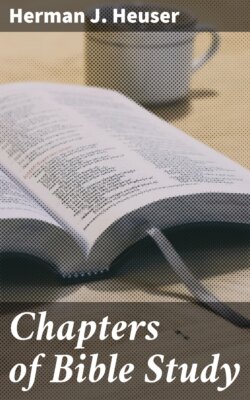Читать книгу Chapters of Bible Study - Herman J. Heuser - Страница 10
На сайте Литреса книга снята с продажи.
THE STONES CRY OUT.
ОглавлениеThe chain of documentary and circumstantial evidence which points to the preservation, substantially intact, of the Bible as an historic record of the highest possible trustworthiness is completed by the daily increasing store of monuments which are brought to light, especially in Palestine, Assyria, and Egypt. Up to the middle of the present century the largest part of our knowledge of the ancient nations was drawn from the Bible. It was the one great treasure-house wherein the history of the East was to be found. We had Greek and Roman and some Egyptian historians, but their knowledge was confined to their own people, and needed to be supplemented by the details related in the Pentateuch, in Josue, Judges, Ruth, the two Books of Samuel, the Books of Kings, Paralipomenon, Esdras, Tobias, Judith, Esther, and the Machabees, all of which are historical books containing facts, statistics, constitutions, and dynastic lines, without which profane history would still be a doubtful and barren field of study.
But, lately, the studious industry of scholarly men has gone over the ground of the old events, to test with the instruments of historic criticism the veracity, and, incidentally, the authenticity of the Bible record. Aided by the royal munificence of governments and private corporations, scholars went to search out and examine the monuments of antiquity in those parts where the Jewish race had dwelt during the periods recounted in the Bible. They found, mostly below the earth, and sometimes beneath the flood-beds of streams and lakes, traces in stone or clay or metal which pointed to their containing valuable information regarding the Persian, Assyrian, Egyptian, and other nations with whom the Hebrew people had come in contact. These traces were sometimes in signs and languages not understood or wholly unknown in our learned world, but with assiduous study the mysteries came, in course of time, to be unravelled. The story of these discoveries is in various ways extremely interesting, and we shall speak of them more in detail later on.
Besides the primitive inscriptions just referred to, a number of cities have been discovered which lay buried for many centuries beneath the ground upon which afterwards other races dwelt and built their homes. Excavations in Palestine go, day by day, to explain, where they do not simply corroborate, the statements of the Bible. The diggings about the supposed ancient site of Nineveh, in Babylonia, have unearthed the ruins of an immense library. Sir A. H. Layard, and subsequently Mr. George Smith and Hormuzd Rassam, have brought together a number of clay tablets which open an immense world of Assyrian and Babylonian literature, whose existence was hitherto known only by the indications given in the Book of Daniel and other historical portions of the Bible concerning the conquerors of the Jews. These discoveries, as Mr. A. H. Sayce remarks in his "Fresh Lights from Ancient Monuments" (page 17), have not only "shed a flood of light on the history and antiquity of the Old Testament, but they have served to illustrate and explain the language of the Old Testament as well."
The evidence brought to light by these monuments has left no doubt in the minds of scientific men as to the facts that occurred three and four thousand years ago. We read the inscriptions which bear witness to the work of the Chaldean king Nimrod, to Zoroaster the Elamite, to Khamu-rabi, the Arab of the days of Moses; we treasure as of primary historical importance the account of Herodotus, who visited Babylon at the time when Esdras and Nehemias, who were both ministers at the court of Artaxerxes, wrote their continuation of the Book of Chronicles for the Jewish brethren in Palestine. When we read the works of Tacitus and Suetonius, of Cicero and Virgil, all of whom indicate that they had some knowledge of the Jewish sacred books,[1] we entertain no doubt as to their existence or the authenticity of their writings; yet men under the guise of scientific criticism have sought to cast doubts upon the Biblical records which have in their favor a documentary evidence a hundred times more accurate and trustworthy than any work of antiquity without exception in the whole range of history. If apologists were silent, the very stones would begin to cry out in behalf of the authenticity and antiquity of the Biblical records. Every day is bringing this truth into stronger relief. "Discovery after discovery," says Prof. Sayce, "has been pouring in upon us from Oriental lands, and the accounts given only ten years ago of the results of Oriental research are already beginning to be antiquated.... The ancient world has been reawakened to life by the spade of the explorer and the patient skill of the decipherer, and we now find ourselves in the presence of monuments which bear the names or recount the deeds of the heroes of Scripture."
[1] Cf. Hettinger-Bowden, "Revealed Religion," page 158.
